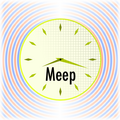Perfectly matched layer
From AbInitio
| Revision as of 20:12, 12 November 2005 (edit) Stevenj (Talk | contribs) (Berenger's medium was split; anisotropic formulation came later) ← Previous diff |
Revision as of 22:27, 23 June 2006 (edit) Ardavan (Talk | contribs) Next diff → |
||
| Line 4: | Line 4: | ||
| The approach involves surrounding the computational cell with a medium that in theory absorbs without any reflection electromagnetic waves at all frequencies and angles of incidence. Berenger showed that it was sufficient to "split" Maxwell's equations into two sets of (unphysical) equations in the absorbing layers, appropriately defined. It was later shown that a similar reflectionless absorbing medium can be constructed as a lossy anisotropic dielectric and magnetic material with "matched" impedance and electrical and magnetic conductivities. | The approach involves surrounding the computational cell with a medium that in theory absorbs without any reflection electromagnetic waves at all frequencies and angles of incidence. Berenger showed that it was sufficient to "split" Maxwell's equations into two sets of (unphysical) equations in the absorbing layers, appropriately defined. It was later shown that a similar reflectionless absorbing medium can be constructed as a lossy anisotropic dielectric and magnetic material with "matched" impedance and electrical and magnetic conductivities. | ||
| - | The finite-difference implementation of PML requires the conductivities to be turned on gradually over a distance of a few grid points to avoid numerical reflections from the discontinuity. | + | The finite-difference implementation of PML requires the conductivities to be turned on gradually over a distance of a few grid points to avoid numerical reflections from the discontinuity. It is important when using PMLs to make the computational cell sufficiently large otherwise the promixity of the PML to evanescent modes may unnecessarily extract energy from the system and thereby perturb it. |
| {{stub}} | {{stub}} | ||
| [[Category:Meep]] | [[Category:Meep]] | ||
Revision as of 22:27, 23 June 2006
| Meep |
| Download |
| Release notes |
| FAQ |
| Meep manual |
| Introduction |
| Installation |
| Tutorial |
| Reference |
| C++ Tutorial |
| C++ Reference |
| Acknowledgements |
| License and Copyright |
The perfectly matched layer (PML) approach to implementing absorbing boundary conditions in FDTD codes was proposed by Berenger in 1994 (see [1]). The approach involves surrounding the computational cell with a medium that in theory absorbs without any reflection electromagnetic waves at all frequencies and angles of incidence. Berenger showed that it was sufficient to "split" Maxwell's equations into two sets of (unphysical) equations in the absorbing layers, appropriately defined. It was later shown that a similar reflectionless absorbing medium can be constructed as a lossy anisotropic dielectric and magnetic material with "matched" impedance and electrical and magnetic conductivities.
The finite-difference implementation of PML requires the conductivities to be turned on gradually over a distance of a few grid points to avoid numerical reflections from the discontinuity. It is important when using PMLs to make the computational cell sufficiently large otherwise the promixity of the PML to evanescent modes may unnecessarily extract energy from the system and thereby perturb it.
- This page is a stub — a placeholder for a more complete article to be added in the future.

